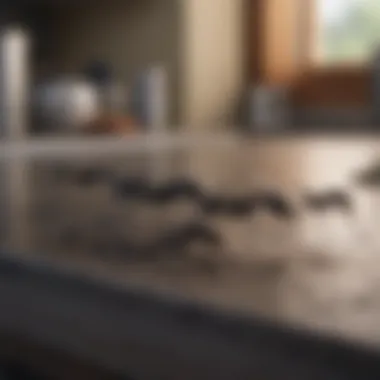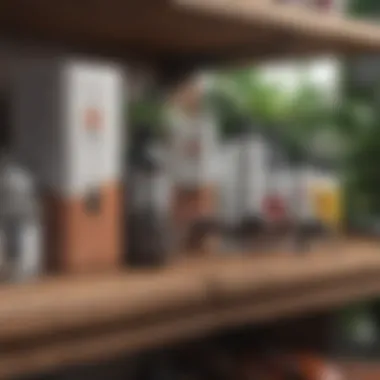Effective Strategies to Eliminate Black Ants from Your Home


Intro
Black ants can be more than just a minor nuisance in a household; their presence often signifies larger issues related to cleanliness and food sources. Understanding these small insects is crucial for effectively eliminating them from your space. This article serves as a thorough resource for homeowners looking to rid their dwellings of black ants, detailing their behavior, habitats, and the best strategies for removal. By focusing on sustainable methods, the guide aims to offer environmentally friendly approaches while addressing the practical needs of the reader.
Fascinating Facts About the Animal
Unique Characteristics
Black ants, belonging to the Formicidae family, exhibit a range of interesting traits. Typically, these insects are small, measuring about 2.5 to 15 millimeters depending on the species. They can be easily identified by their smooth, shiny exoskeletons that often appear black or dark brown.
In addition to their physical attributes, black ants are known for their remarkable adaptability. They can thrive in various environments, from forests to urban settings. This adaptability allows them to search for food and nesting sites effectively.
Extraordinary Abilities
Black ants possess a variety of abilities that enable them to survive and thrive. They are excellent navigators, utilizing pheromone trails to communicate with fellow ants and direct them toward food sources. Additionally, they exhibit a remarkable level of teamwork, working collaboratively to transport food that can be several times their body weight. Such cooperative behavior is vital for the functionality of their colonies.
Behavior and Habitat
Natural Habitats
Black ants typically inhabit diverse environments. They can be found in gardens, lawns, and even inside homes. The nests they build often consist of intricate tunnels and chambers, which serve as a secure habitat for the colony. Their ability to adapt enables them to enter homes through various cracks and crevices.
Social Structures
The social structure of black ant colonies is complex. Each colony consists of a queen, workers, and sometimes drones. The queen is primarily responsible for reproduction, while workers handle foraging, nest maintenance, and brood care. This hierarchical structure allows for efficient functioning within the colony, making them incredibly effective at finding food and expanding their territories.
Recent Scientific Discoveries
Latest Research Findings
Recent studies have explored the fascinating world of black ants in greater detail. Research highlights their impressive communication methods and social dynamics. For instance, scientists have discovered that black ants can differentiate between various pheromones, effectively enhancing their scavenging efforts.
Breakthroughs in Animal Biology
In the realm of biology, breakthroughs have shed light on how black ants cooperate during foraging. Studies reveal that they can optimize their foraging routes and adjust their behaviors based on food availability, showcasing a high degree of intelligence for such small creatures.
Cultural Significance
Animals in Folklore
Black ants, while often seen merely as pests, hold a place in many cultures and folklore. In some traditions, they symbolize diligence and perseverance due to their hard-working nature. This perception reinforces positive associations with collaboration and community.
Influence on Art and Literature
While less common, black ants have also made their appearance in various art forms and literature. Their representation often serves to illustrate themes of teamwork or the unseen struggles of the smaller creatures in our ecosystems. Such literary interpretations provide a more profound understanding of their role in nature.
Understanding the nuances of black ants not only helps in their elimination but also encourages a greater appreciation for their role in the environment.
As we delve into the methods for removing black ants from your home, consider both the practical and ecological implications of your actions. Next, we will explore effective strategies for prevention and removal.
Understanding Black Ants
Understanding black ants is crucial for addressing their presence in your home. These insects can often go unnoticed until they become a more significant problem. By familiarizing yourself with their characteristics and behaviors, you can take better preventative measures and effectively eliminate them. The significance lies not only in the nuisance they create but also in the potential damage to your property and the health implications they can pose.
General Characteristics of Black Ants
Black ants typically exhibit a robust body structure, usually ranging from a quarter to half an inch in size. These ants possess a shiny black exterior, which makes them easily identifiable. Unlike some other ant species, black ants do not have a distinct waist. They possess long antennae and six legs, providing them with the agility needed to navigate various terrains. Their colony structure is intricate; they live in groups with a clear hierarchy, including workers, soldiers, and a queen.


Common Species Found in Homes
Different species of black ants may invade homes, but some are more common than others. Among these, the Carpenter Ant and the Odorous House Ant are frequently encountered. Carpenter ants are known for nesting in wood, potentially causing structural damage over time. On the other hand, Odorous House Ants produce a distinct odor when crushed, making them recognizable. It is vital to identify which species is present in your home to choose the most effective control methods.
Habits and Behavior Patterns
Black ants display specific habits that can provide insights into their behavior. They are primarily foragers, seeking food in various environments, which often brings them into homes. Their foraging trails can be observed along edges of walls or countertops. These ants are also social insects; they communicate with each other to coordinate foraging and other activities. Their colonies can grow large, sometimes numbering in the thousands. Understanding these patterns will help in managing their presence effectively.
"Awareness of black ants' characteristics and behaviors is key to effective management of their populations in residential spaces."
Identifying the Infestation
Identifying an ant infestation is crucial in tackling the problem effectively. Knowledge about the signs, entry points, and severity of the infestation can save time and resources. First, understanding the nature of the infestation helps in choosing the right removal strategy. Not addressing the signs of an infestation can lead to larger colony growth, which makes it harder to manage. This section provides insights into recognizing these signs, understanding common entry points, and assessing the severity of the problem.
Signs of an Ant Infestation
The first step in recognizing an ant problem is by looking for clear signs of their presence. These signs include:
- Sighting Ants: Observing ants marching in lines is often the most evident indication of an infestation.
- Nesting Sites: Look for nests in wood, soil, or beneath concrete slabs. Ant nests can sometimes be identified by small piles of soil or debris.
- Droppings: Small black droppings may appear near their paths, indicating their food sources and nesting areas.
- Food Sources: Finding food packaging that has been broken into or contaminated can signal a nearby colony.
- Pheromone Trails: Ants leave a pheromone trail for others in their colony. Following the trail often leads you to their food source or nest.
Identifying these signs early can prevent a small problem from escalating into a larger infestation.
Common Entry Points
Ants are skilled at finding entry points into homes. Awareness of these areas can assist homeowners in taking preventative measures. Common entry points include:
- Gaps and Cracks: Small fissures in walls, foundations, or around doors and windows can serve as gateways.
- Holes in Screens: Any tears or gaps in window screens can make it easier for ants to enter.
- Utility Entry Points: Areas where pipes and wires enter the house can provide easy access; ensure these are sealed properly.
- Outdoor Pathways: Ants may travel along tree branches, shrubs, or other vegetation that contact the home.
Knowing where these entry points are located will guide you in sealing them properly to prevent further invasions.
Assessing the Severity of the Problem
Understanding the severity of an ant infestation is vital for deciding on the most appropriate control method. Assessing the issue involves:
- Counting Ants: Note the number of ants observed. A small number often indicates a minor issue, while a larger presence signals a more significant infestation.
- Identifying the Species: Different species behave differently. Knowing what type of black ant you are dealing with can influence the choice of control measures.
- Examining Nest Size: If you locate a nest, reviewing its size can indicate the colony’s strength. A larger nest suggests a well-established colony.
- Observing Foraging Habits: If ants are actively foraging for food inside the house, it suggests they have a viable source nearby, further indicating the urgency of the issue.
Being diligent in recognizing ant troubles can empower you to act decisively, ensuring that your home remains ant-free.
Preventative Measures
Preventing a black ant infestation is crucial for maintaining a comfortable living space. Taking proactive steps can significantly reduce the likelihood of ants invading your home. Understanding how to deter these pests ensures not only the immediate comfort of your household but also aids in long-term pest management strategies. Implementing preventative measures is often more effective than dealing with an established infestation.
Maintaining Cleanliness at Home
A clean home is less attractive to black ants. Regular cleaning routines help eliminate food sources that may lure these pests. Focus on the kitchen and dining areas, where crumbs and spills are common. Vacuuming frequently and wiping down surfaces is essential. Pay special attention to corners and under appliances, as these areas often collect food debris unnoticed.
Another important aspect is managing waste properly. Use sealed containers for food scraps and garbage. Ants are hungry creatures. They will find any food source if it is accessible. Regularly taken out the trash can prevent odors that attract them.
In addition to surfaces, don’t forget about the yard. Keeping the exterior of your home tidy stops ants before they enter. Remove leaves, branches, and other debris. Ensure that mulch and garden materials are kept away from the foundation.
Sealing Entry Points
Sealing entry points is an effective way to limit access for black ants. They can squeeze through small cracks and gaps around the home’s structure. Inspect exterior walls, windows, and doors for any openings. Using caulk or weather stripping can effectively block these gaps.
Pay close attention to utility lines and vents as well. Ants may traverse through these areas in search of food and shelter. Sealing these areas is vital in creating a barrier against infestations. Repair any damaged screens on windows and doors to add an extra layer of protection.
Regular inspections should be part of your routine home maintenance. Checking these areas not only helps with ant issues but also with other pests.
Proper Food Storage Techniques


Proper food storage is key to keeping your home ant-free. Use airtight containers for storing foods, particularly sugar, grains, and pet food. These containers should be made from materials that ants cannot penetrate. Label your containers to keep track of contents, as this helps in managing what needs to be used first.
In the pantry, avoid leaving open packages of food. Ants can easily detect these food sources. It’s also wise to store any bulk foods in sealed containers. Regularly inspect food storage areas for any signs of pest activity.
Keeping the refrigerator and freezer organized also matters. Ensure that no food is left out that might attract ants. Consider keeping fruits and vegetables in the fridge if they are not consumed quickly.
Focusing on cleanliness, sealing entry points, and proper food storage techniques creates an effective strategy against black ants.
By combining these strategies, you create a strong foundation for preventing a black ant problem at home. Applying these measures reinforces your commitment to maintaining a pest-free environment and contributes to your home’s overall sanitation.
Natural Remedies for Black Ants
Natural remedies serve an essential role in managing black ant infestations. They are often preferred for being less toxic than many chemical treatments, reducing health risks to inhabitants, including pets and children. Moreover, these methods are usually more environmentally friendly, aligning with sustainable practices. It's important to consider that while natural remedies can be effective, they may require persistence and multiple applications to achieve desired outcomes. Understanding the properties of common natural ingredients can facilitate their proper use.
Using Vinegar and Water Solutions
Vinegar is a common household item known for its versatility and effectiveness as a natural ant repellent. A straightforward solution can be made by mixing equal parts of vinegar and water in a spray bottle. This mixture disrupts the scent trails that ants leave behind, ultimately deterring them from returning. To use it, simply spray areas where you’ve noticed ant activity, such as counters, windowsills, and entry points. The strong smell will repel them, but it is essential to repeat this application regularly for sustained results.
Essential Oils and Their Efficacy
Essential oils are widely recognized for their pest control properties, including those against black ants. They provide a non-toxic alternative to chemical insecticides, appealing to those seeking safer options. Specific essential oils that are particularly beneficial include peppermint oil, tea tree oil, and cinnamon oil.
Peppermint Oil
Peppermint oil has a strong scent that acts as a natural deterrent for black ants. Its key characteristic lies in its intense fragrance, which overwhelms ants’ sensory capabilities. This makes peppermint oil a popular choice in natural pest control. Moreover, its mild insecticidal properties can help reduce ant populations when mixed with water and applied to affected areas. However, it is critical to reapply frequently as the scent fades over time.
Tea Tree Oil
Tea tree oil is another effective solution for tackling black ants. Known for its antiseptic qualities, its key feature is its strong aroma, which can disorient ants and make locations less attractive. It is beneficial because it not only repels ants but also inhibits their ability to communicate via pheromones. A potential drawback is its cost and strong scent, which some individuals may find overwhelming. Using it sparingly can mitigate these issues.
Cinnamon Oil
Cinnamon oil is renowned for its powerful scent and insect-repelling qualities. Its main characteristic is the active compound cinnamaldehyde, which can disrupt ant activity effectively. This oil is a favorable option in natural remedies due to its accessibility and pleasant scent compared to other oils. However, like other essential oils, it may need frequent reapplication to maintain effectiveness, especially in high-traffic areas.
Boric Acid as an Ant Bait
Boric acid serves as a potent natural bait for black ants. It works by disrupting the digestive system of ants when ingested. Typically, it is combined with a sweet substance, like sugar or honey, to attract ants. Once they consume the bait, they carry it back to their colony, leading to a more widespread impact. Caution is necessary when using boric acid; it is toxic to pets and humans if ingested in large amounts. Placing it strategically in locations away from children and pets is crucial to prevent accidental exposure.
Chemical Treatments
Chemical treatments play a significant role in eliminating black ants effectively. These methods often provide immediate results when compared to natural remedies. However, it is essential to approach chemical solutions with caution. They can be potent against ant colonies but may also pose risks to children, pets, and the environment if not used properly. Therefore, understanding the type of insecticides available, how to apply them safely, and exploring eco-friendly alternatives is crucial.
Types of Chemical Insecticides
When it comes to chemical insecticides, several categories exist, each designed to target ants specifically. The main types include:
- Baits: These products attract ants with food, which they take back to their nests. Active ingredients typically affect the colony over time. Popular examples are those containing hydramethylnon or fipronil.
- Sprays: Ready-to-use sprays offer a direct approach. They provide quick knockdown of visible ants. Pyrethroids, like permethrin, are commonly found in these sprays.
- Granules: These insecticides can be spread in outdoor areas. They work by combining with soil moisture to dissolve and reach ants in their nests. Some granules contain deltamethrin.
Choosing the right type depends on the situation. Baits generally offer a long-term solution, while sprays are effective for immediate control. Granules are useful for preventing future infestations in gardens and near entry points.
How to Apply Chemicals Safely
Applying chemical treatments requires care to minimize risks. Here are some guidelines to follow:
- Read Labels: Always read the product label thoroughly. This ensures proper usage and highlights any safety precautions.
- Apply at the Right Time: Early morning or late evening is ideal when ants are most active. Avoid windy days to prevent drift.
- Use Protective Gear: Wearing gloves and masks can protect against skin contact and inhalation of chemicals.
- Keep Area Clear: Before application, remove pets and children from the vicinity. This reduces the risk of exposure.
- Follow Dosages: Adhere strictly to recommended dosages. Over-application can be dangerous and does not enhance effectiveness.
By following these practices, one can mitigate health risks and still achieve effective ant control.
Eco-Friendly Chemical Alternatives


For those concerned about the environmental impact of traditional insecticides, eco-friendly alternatives exist. Some noteworthy options include:
- Insecticidal Soaps: These break down the outer layers of an insect's body, causing dehydration. They are safe for pets and plants, making them a good choice for households.
- Diatomaceous Earth: This natural powder kills ants by causing physical damage to their exoskeletons. It's safe for use around the home and effective when applied in targeted areas.
- Botanical Insecticides: Derived from plant extracts, these insecticides can target ants effectively with less environmental impact. Examples include those containing neem oil.
Using eco-friendly alternatives treats the ant problem without compromising health and ecological balance.
It is important to assess your unique situation and choose a method that aligns with your priorities, be they effectiveness, safety, or environmental impact.
Long-Term Solutions and Maintenance
Maintaining an ant-free home is not just about addressing an existing infestation; it involves continuous efforts to prevent future occurrences. Long-term solutions and maintenance are vital for sustaining a pest-free environment. Focusing on this aspect allows homeowners to integrate effective strategies that also protect the surrounding ecosystem and promote public health.
Regular Inspections and Monitoring
Conducting regular inspections is a proactive measure. Homeowners should frequently assess both the inside and outside of their homes. Checking for signs of black ants, such as trails or nests, helps catch infestations early. Effective monitoring tools can include simple bait traps, which can give clear indications of ant activity.
- Look for key areas to inspect, including:
- Kitchen
- Pantry
- Basements
- Near windows and doors
Ensuring these areas are kept under observation can help maintain control over a potential infestation.
Implementing Integrated Pest Management
Integrated Pest Management (IPM) provides a holistic approach to ant control. This method combines various strategies to manage pest populations effectively. IPM focuses on understanding the life cycle of black ants, identifying their habitats, and using a combination of non-chemical and chemical solutions when necessary. Practices may include:
- Habitat Modification: Make changes to deny ants food and shelter.
- Cultural Controls: Implementing good sanitation practices like promptly cleaning spills or securing food items.
- Biological Controls: Introducing natural predators to ants.
By using IPM, homeowners take a balanced approach, respecting both their home and the environment.
When to Call Professionals
There are times when black ant infestations exceed the capability of DIY methods. Knowing when to call professionals is crucial. If the infestation spreads rapidly or proves difficult to manage despite efforts, seeking expert help is advisable. Professionals possess advanced knowledge and tools, allowing them to deal with infestations effectively.
Consider contacting pest control services when:
- The infestation increases despite your best efforts.
- Ant nests are found deep within wall voids or other inaccessible areas.
- Ants exhibit aggressive behavior that may pose risk.
A professional pest management approach saves time and preserves the long-term integrity of your home.
Epilogue
In this article, we explored the multifaceted issue of black ants invading homes, emphasizing the need for a structured approach to eliminate them. The importance of this topic cannot be understated, especially for those who value a clean and healthy living space. Understanding the characteristics, behaviors, and entry points of black ants is essential for effective control.
By summarizing key points, readers can quickly grasp the various methods available. The article addressed both natural and chemical strategies, illustrating the trade-offs between efficacy and environmental impact. Each method has its own benefits and considerations, making it crucial for homeowners to select the most suitable approach based on their unique circumstances.
Furthermore, the significance of maintaining cleanliness and sealing potential entry points cannot be overlooked. These preventative measures form the first line of defense against infestations, saving time, money, and effort in the long run. A proactive mindset, combined with the right techniques, can substantially reduce the likelihood of recurring ant problems.
The discussion surrounding sustainable practices underscores the responsibility homeowners have toward the environment and public health. Many natural solutions offer effective means for ant control without resorting to harsh chemicals. This aspect is particularly vital for families, especially those with young children or pets, who may be more susceptible to the adverse effects of commercial insecticides.
Ultimately, the key takeaway from this article is empowerment. Armed with knowledge and actionable steps, readers can confidently tackle ant infestations. Understanding when to call professionals or when to implement long-term solutions will further enhance their ability to maintain an ant-free home. By staying informed and vigilant, homeowners can foster a more harmonious living environment free from the nuisance of black ants.
Summary of Key Points
- The importance of understanding the habits and characteristics of black ants was highlighted.
- Recognizing signs of infestation and sealing entry points are vital steps in prevention.
- A variety of natural and chemical remedies exist for managing infestations effectively.
- Regular maintenance and monitoring will help ensure long-term success in keeping homes ant-free.
- Sustainable methods are encouraged to protect both health and the environment.
Encouragement for Sustainable Practices
Opting for sustainable practices in the fight against black ants is not only beneficial for individuals but also crucial for the planet. Homeowners are encouraged to start with less harmful methods, gradually moving to more intensive strategies only if necessary.
Embracing natural solutions like vinegar, essential oils, and boric acid can prove quite effective. Using eco-friendly insecticides can minimize chemical exposure while still addressing the pest problem.
Additionally, homeowners should consider their overall maintenance routines. A consistent cleaning schedule and proactive measures such as sealing cracks and crevices can help ensure that homes remain inhospitable to ants. These simple steps are practical and require little investment, yet they yield significant long-term benefits.
In summary, sustainable practices in pest control reflect a thoughtful consideration for both personal health and the environment. When informed choices guide actions, individuals contribute positively to not just their homes but also the wider ecosystem.







